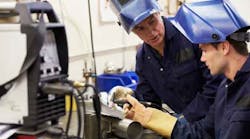Employee Stock Ownership Plans got a bad rap during the Enron era, when criminal leadership left employees with nothing. But transferring ownership to employees over time with an ESOP can be a healthy option for owners of manufacturing companies who don’t have family members or a natural successor to take over.
“I find that when you walk into an employee-owned company, there’s a different vibe,” says Lee Swerdlin, president and chief operating officer of actuary firm Swerdlin and Co., based in Atlanta. “You go into a [big non-employee owned supermarket chain] and ask where the milk is, they’re typically going to point and say Aisle 9. You go into a Publix, and they walk you to the milk aisle.”
ESOPs tend to work best at companies of more than 25 employees with stability over the long term, reliable returns and loyal workers who understand the culture. Manufacturing companies, with their steady-as-she-goes reputation and a tight-knit culture, tend to fit the bill better than most, says John Shurley, a CPA and member at Warren Averret accounting firm in Atlanta.
“Buyers that are out there are looking for companies that grow at multiple double-digit returns—to flip in five or 10 years,” says Shurley. “And a lot of times our manufacturing clients are just steady pace—a good 20% annual return, and they have their standard customers that they’ve been supplying for years.”
Some 7,000 U.S. companies with a total of 13.5 million employees had ESOPs in 2014; big manufacturing names in the ESOP world include Amsted Industries and W.L. Gore and Associates.
ESOPs, which transfer stock ownership of a company to employees, typically over a decade or two, give the owner liquidity, a tax break and a perk to attract new employees and improve morale among existing ones.
Swerdlin recommends starting to plan for an ESOP five to 10 years or so before you actually roll it out. ESOPs are complex to set up—and cost $50,000 to $100,000 to do so—so “the more time you have to understand the concept, the better,” he says. “It’s not something you can do on the back of a napkin.”
You’ll need a feasibility study to determine the value of your company and whether it’s a good fit for an ESOP. “If you talk to 100 companies, maybe only 10 are good for an ESOP. It takes the right kind of culture, the right kind of owner.”
While negotiations with the bank and getting all the paperwork done can take three to six months, it takes much longer to involve your employees in the succession process and decide on trustees to run the ESOP.
“We usually recommend that a company looks into open-book management if they don’t have a form of it already,” says Swerdlin. “It doesn’t mean you have to share everything with your employees, but it makes the transition a little easier if they understand a little bit how the business runs.”
Swerdlin says that the companies with the most ESOP success are into the “long game, really educating their employees and the employees get what the ESOP means. The ones where the owners take their money out to get the tax benefit and they’re gone and they leave the company that they’ve been working to build all these years with an ESOP no one really understands—those are situations where things do not go well and get really complicated.”
Companies where the employees get it are easy to spot—they wear “employee-owned” on their logo, or answer the phone “Hi, this is ABC widget company—we’re an employee-owned company,” says Swerdlin. Some have ESOP committees that include rank and file employees, “to have them be stewards and help other employees understand it. There’s a lot of education that goes into it.”



